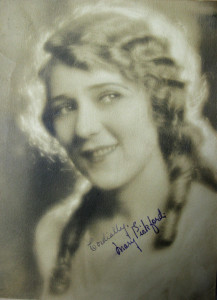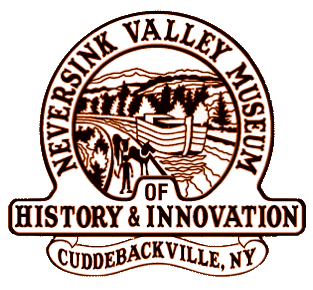Early Movie Making in the Neversink River Valley
The common thread connecting most of the important events and places in our area is the Neversink River. It was an important source of water for the D & H Canal, that feeder was converted after the demise of the canal for use by the Neversink Valley Power and Light Company’s hydroelectric plant and it was just that project that led some of the most important names in the motion picture industry to Cuddebackville.
In the early 1890’s, Thomas Edison assigned one of his employees, William Kennedy Laurie Dickson, the task of producing a continuous series of sequential photographs which when presented to the eye would appear to move. The result was the Kinetoscope. Dickson left Edison’s employ in 1895 and went to work at the Magic Introduction Company. Their motion picture machine, the Mutoscope contained one thousand paper photographs printed from a film negative mounted around a drum. The cards would flick by an eyepiece and create the image of movement. The camera that took the pictures was carefully designed not to infringe on any of Edison’s patents. The company changed its name to The American Mutoscope Company and that year created the Biograph Projector. The man who operated this at its world premiere on October 12, 1896, was Billy Bitzer.
Soon the “Biograph Company” as it became known was offering theatres a package of films, projector and projectionist. They competed directly with Edison’s company. Some of their early films included the dancer “Little Egypt” and such titles as “How Girls Go to Bed” and “How Girls Undress.”
Progress continued for the next few years in both the U.S. and Europe. Longer films were being made, short stories were told instead of scenes from real life, and better techniques and more creative camera effects were being used. For the most part however, films were made by photographing scenes like a stage play in front of a stationary camera.
In early 1908 an actor, David Griffith, came to Biograph to work in pictures. He brought with him an actress, Linda Arvidson, who was actually Mrs. Griffith, though they kept that secret. In spring of ‘08, Griffith directed his first film, The Adventures of Dollie. In August of that year, Griffith directed his first film with Bitzer as camera man, called A Calamatous Elopement. Bitzer had already photographed more than 150 films by this time.
In 1909 scripts needing wild mountainous country had been collected and Griffith, Bitzer and the company’s secretary, Mr. Kennedy, met to discuss where to film them. A few years earlier, Kennedy had worked on the damn at the Neversink feeder which supplied the water to the hydroelectric plant. He knew Cuddebackville; it had the right scenery, housing facilities and no summer boarders.
“It was a five hour trip from New York City to this new location: a ferry across the Hudson, a train trip along the river to West Point, then through the Orange Mountains to the tiny station at Cuddebackville. Theirs was the longest stop the O & W railroad made at this town. Mr. Predmore, who owned the Caudebec Inn met them at the station with a wagon and his “red devil,” the second automobile in Orange County.” According to Arvidson.
Mr. Predmore would take Bitzer and Griffith on location hunts in the car. Meanwhile the carpenters would set to work and the actors would begin getting into make-up and costume, so they could take advantage of any remaining light and be ready to shoot as soon as Griffith got back.
The Mended Lute was the first picture produced there. It featured Florence Lawrence, Owen Moore and James Kirkwood.
When they needed extras, they would find local farm hands and pay them five dollars a day. “Arvidson wrote “back at the farm at five per week after that? No, they’d wait and loaf until the picture people came again. The picture people nearly demoralized the farming business in Cuddebackville” and got the labor situation in “a terrible mess.”
Back at the Inn, the actors would be changing out of make-up and going into dinner in small groups, their appetites were so great, they wore out Mrs. Predmore and her cook. In the evenings, some of the crew would ride into Middletown. Some, like Mary Pickford and Owen Moore would take a canoe ride on the old D & H Canal. In fact, Owen courted Mary on the Canal before they married. Others would gather at the Inn and sing songs, or tell ghost stories, sometimes taking trips through the cemetery.
Mary Pickford was a valuable member of the company. She was skilled at writing stories and with make-up, too often teaching the other girls how to apply it properly. It was not surprising to those who knew her that she became one of the founders of United Artists Pictures.
Other films made that first year included, Indian Runner’s Romance, In Old Kentucky, Comata the Sioux, 1776 (The Hessian Renegade) and A Fair Exchange.
In the winter, as the weather got cold, Griffith and the Biograph troupe made their first trip to Los Angeles. The following August found them back in Cuddebackville. Once, when they wanted to film a scene in the cemetery, some of the town folk objected. Actors not needed for the scene staged a fake one at the general store. All the villagers came to watch while the real crew filmed what they needed at the cemetery. This second year, films made in Cuddebackville included Willful Peggy, A Summer Idyll, The Modern Prodigal and That Chink at Golden Gulch.
By 1913, Griffith decided to make bigger and better films and left the Biograph company in October of that year. In December, Bitzer followed him as did most of the Biograph actors. Mack Sennett, along with his on again-off again love Mabel Normand became the king of comedy and invented the Keystone Kops at his Keystone Studios, Dorothy and Lillian Gish acted to the ends of their lives and Mary Pickford divorced Owen Moore, married Douglas Fairbanks and became a Hollywood legend.
Griffith and Bitzer went on to film The Battle of the Sexes and a Civil War drama in 12 reels: Birth of a Nation. This controversial classic was followed by Intolerance, Broken Blossoms and in 1920, Way Down East, which had its world premiere at the Stratton Theatre in Middletown, NY. Bitzer’s last film was Lady of the Pavements in 1929 and Griffith’s was 1931’s The Struggle, one of only two “talkies” he made. Griffith died in 1948 after living in near seclusion for the last 17 years of his life. Bitzer had died four years earlier.
Mary Pickford said once of the D &H Canal that coursed through Cuddebackville, “I used to think this canal was the most beautiful place on earth…” Lillian Gish said in the 1980’s that had our climate matched that of Los Angeles, there would have been no reason to head west, and our Neversink Valley would have been the motion picture capital of the world.
Copyright 2007 Seth Goldman

Short Link:
